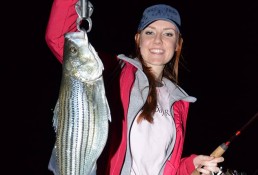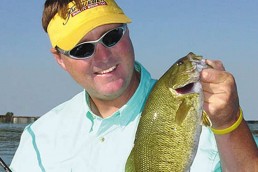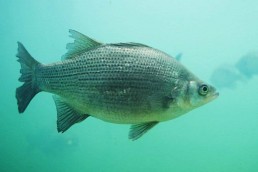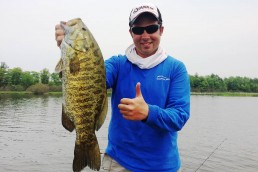Big Striped Bass Rise to Baits as the Sun Goes Down
Somewhere between a mountainous shoreline thick with lure-eating brush during daylight hours and us, a large fish splashed. With no moon to illuminate the rugged Ozark Mountains, we couldn’t judge distances very well.
Was the shoreline 20 yards away or 100?
Making distance calculations even more tricky, a point projected out from that dark shoreline toward the boat. We unleashed our lures in the general vicinity of the stygian shoreline, intently listening for the reassuring splashes of them hitting the water rather than a disheartening clunk. Splash! Success—this time.
“Shad move up on the banks at night,” explained Steve Olomon, of Steve’s Guide Service (870-491-5142, fishingwithsteve.com), on Norfork Lake near Mountain Home, Ark. “Stripers move up shallow at night to feed. Sometimes, they get right on the banks. We want to put the bait close to the shoreline, but not on it. With a good breeze like we have tonight, a Smithwick Rogue can really sail on light line. At night, stripers don’t like to hit a lure if it’s going too fast. Reel it very slowly. The slower the better, just so it wobbles back and forth. Don’t jerk it like when fishing for largemouth bass.”
In the incredibly transparent water of this deep lake, fish can see even at night. They might rise 50 feet to smack a bait on the surface, but we couldn’t see the lure wobbling almost painfully slowly at the end of the line. Large predators could detect the movement of a silhouetted morsel seductively wobbling just under the surface. The first lure didn’t move very far before a vicious beast smashed it and raced for open water, nearly pulling the rod with it. On the boat, 19-year-old Valory Zortman fought her first striper.
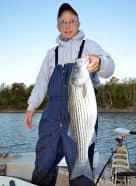
“Norfork Lake is well-known for its striper fishery,” advised Tom Reynolds, of STR Outfitters in Mountain Home (877-246-4896). “The state originally stocked striped bass into the lake in the 1960s and continue to stock stripers and hybrid bass each year. The lake has a good population of stripers averaging about 10 to 12 pounds, but we catch some fish in the 20- to 40-pound range. Occasionally, someone lands one topping 50 pounds.”
Just outside Mountain Home, Norfork Lake began with a dam on the North Fork of the White River in 1944. Slicing a path through the ancient Ozark Mountains of Missouri and northern Arkansas, the North Fork runs about 109 miles until it hits the White River at Norfork, Ark., below Norfork Lake. The White River snakes 720 miles through Arkansas and Missouri before turning southerly to hit the Mississippi River in southeastern Arkansas.
Norfork Lake runs about 47 miles along the river channel. No other rivers flow into the lake, but the dazzling waters spread through myriad mountain coves totaling about 22,000 surface acres at pool stage. The lake drops to more than 200 feet deep near the dam. The U.S. Army Corps of Engineers controls the 550 miles of shorelines, preventing most development. The COE strip of land may extend back from the water a few hundred feet or nearly a mile.
During daylight hours, visitors see rocky bluffs and forested shorelines touching crystal waters reminiscent of a remote lake in boreal Canada. At first light, anglers fishing a wooded point might hear turkeys gobbling or see bald eagles hunting prey. Sometimes, deer walk along the boulder-strewn shorelines. Just a cast away from shore, the boat could sit in more than 100 feet of water.
“It’s somewhat isolated with no superhighways passing close to it so it doesn’t have any really big boats on it,” Reynolds said. “On the weekends, it gets some boat traffic, but Norfork doesn’t get nearly the pressure of other lakes. During the week, we hardly see another boat. Since the water is so clear, night fishing can be outstanding. The stripers can see baitfish at night as they move into the shallows.”
This adventure began just as the day ended and a chilly night started. Hall of Fame outdoor writer Kenny Kieser, Valory, the daughter of our hosts at Mockingbird Bay Resort, and I ventured into the darkness with Steve to tempt nocturnal stripers. Normally, Steve runs out of Quarry Marina near the dam, but picked us up in his Legend boat on this breezy, twilight at the Mockingbird Bay Resort where we stayed. That morning, Valory caught her first fish ever, a Kentucky spotted bass, while fishing with Steve. Besides those fish mentioned, the lake also holds smallmouth and largemouth bass, Ozark bass, walleyes, crappies, bream, catfish and other fish. In the tailrace below the dam, anglers catch several trout species.
“We’re fishing a gravel flat close to the bank,” Steve advised as he powered down the outboard at the honey hole. “Stripers like gravel flats, like where smallmouths would go. Sometimes, the fish are off the end of the points. Sometimes, they might be off to one side. I’ll keep the boat in about nine to 11 feet of water as you throw toward the shoreline.”
While Steve maintained the boat position and kept a Frabill net handy, the rest of us propelled our jerkbaits toward the general vicinity of the shadowy shoreline. We used light spinning rods loaded with 10-pound-test monofilament because we didn’t anticipate hitting any snags in the clear-cut lake—as long as we hit the water on the cast!
“It’s a little tougher to catch stripers on artificial baits, but I like the challenge of tempting big fish on light tackle with lures,” Olomon remarked. “I know of at least one 53-pound striper that came out of this lake. A lot of people fish at night with artificials because in that extremely clear water, fish can get spooky.”
When tempting stripers at night, keep noise to a minimum and avoid shining any lights onto the water, particularly toward the chosen shoreline. That could spook fish. When preparing tackle or taking care of a problem in the boat, use a small LED light and shine it into the bottom of the boat instead of over the water.
“Stripers don’t like a lot of light,” Olomon explained. “Even when an electrical storm comes up, that shuts down the striper bite for a day or two. A little talking doesn’t hurt anything, but avoid banging things around in the boat. Sound travels through the boat hull into the water.”
Every few casts, one of us hooked a fish. When someone hooked a powerful fish, the others pulled in their lines to avoid a tangled mess, but we did manage a couple doubles. After about 90 minutes, we head back to Mockingbird Bay Resort after catching and releasing 14 stripers and missing several others. Valory landed a double-digit hybrid striped bass, a hatchery-raised combination of a striped bass and a white bass.
“We catch hybrids the same way we catch stripers,” Olomon advised. “Hybrids often run with stripers. Sometimes, we catch a striper on one cast and a hybrid on the next cast with the same bait.”
For lodging, call Frank or Loretta Zortman, owners of Mockingbird Bay Resort, at 870-491-5151.
For more information…
STR Outfitters in Mountain Home (877) 246-4896, stroutfitters.com
Steve’s Guide Service (870) 491-5142, fishingwithsteve.com
Mockingbird Bay Resort, (870)-491-5151 mockingbirdbayresort.com, fishnorfork.com
MWO
SHARE THIS POST
Did you enjoy this post?
You can be among the first to get the latest info on where to go, what to use and how to use it!
John N. Felsher
John N. Felsher grew up in Slidell, La., and now lives in Semmes, Ala. He’s a professional freelance writer and photographer with more than 2,100 articles in more than 135 different magazines to his credit. He also co-hosts a weekly live outdoors radio show every Thursday from noon to 1 p.m. Central Time on WNSP 105.5 FM in Mobile, Ala. and a recorded syndicated show that goes out to multiple stations in Alabama each week. For more info on the syndicated show, see gdomag.com. Contact him at JohnNFelsher.com.
